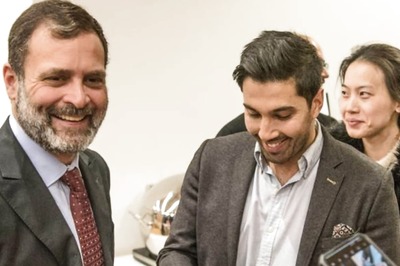
views
As the negotiations for the transfer of power began towards the end of the Second World War, it was clear that the Congress organisation could not continue as a platform, accommodating a wide range of political views. The differences between various groups in the organisation had started to become too sharp to let them coexist. The Communist Party of India (CPI) was the first party to be thrown out.
Soon after his release in June 1945, Jawaharlal Nehru started accusing the CPI of acting against the national movement. A committee appointed in September 1945, comprising Nehru, Vallabhbhai Patel and Govind Ballabh Pant concluded that “there is ample evidence on record before us to establish a strong prima facie case against the members of the Communist Party in the Congress”. In response, P.C. Joshi, the general secretary of the CPI, asked all communist members of the Congress to resign, except those who were members of the All India Congress Committee (AICC), so that they could respond to the charges.
Accusing the CPI of mounting “a tirade against the Congress” in the tone of “self-righteous arrogance” instead of answering specific charges, Nehru, Patel and Pant recommended the expulsion of all the communist members of the AICC and instructed the Provincial Congress Committees to remove all communist members from elective offices in December 1945.
Although Mahatma Gandhi’s views counted for little during the last phase of negotiations on the transfer of power, he was still the biggest cementing factor in the organisation. This became clearer as groups and leaders started moving away from the Congress after his assassination in January 1948. Soon after, the Congress Socialist Party decided to move out of the Congress as a separate political party in March 1948, despite their ideological proximity to Nehru. Writing in the Amrita Bazar Patrika mid-January, Jaya Prakash Narayan had explained that the key question in front of them was — can we build up a socialist India by remaining within the Congress or by working outside it?
The Congress, Narayan wrote, had transformed into a parliamentary party and those like Gandhi who struggled to build Congress as “a body of voluntary servants of the people” were losing the battle. Having become a source of power and personal advancement, the Congress was fast becoming a centre for vested interests resulting in corruption and jobbery. The moral edifice of the Congress had collapsed, he accused.
He was particularly critical of Patel’s statements disparaging political ‘isms’. Narayan wrote, “When Sardar Patel decries socialism, he is defending the status quo and is saying that his ism, namely, status-quo-ism is superior to all others.” Patel was not unhappy with the exit of the socialists. “I have all along been of the view that if the future of India is in the hands of men like Jai Prakash [sic], it would probably be a most unfortunate circumstance,” Patel wrote to Nehru on June 15.
Gandhi himself had actively taken up the question of the Congress organisation towards the end of his life. In a draft constitution for the Congress that he prepared a day before his assassination, Gandhi proposed disbanding the organisation and forming a Lok Sevak Sangh instead, which would be organised on the basis of village panchayats.
The relationship between Patel and Nehru was also rocked by serious differences, both on matters of organisation and governance, and on more than one occasion, both offered to resign. The differences were settled through Gandhi’s mediation and his death temporarily brought the two closer. However, the differences were too stark to be pushed under the carpet and reached the climax over the Congress presidential election of 1950. Angry with Nehru’s unilateral selection of J.B. Kripalani as a candidate, Patel threw his weight behind Purushottam Das Tandon. This in turn upset Nehru. Patel passed away a few months later in December 1950. Had he lived a few more years, it is difficult to say where such deep differences would have taken the top two leaders of the Congress party and the government.
The next break in the Congress came from within the party, and more significantly, from some of the leaders who had formed the bulwark of the Gandhian high command. Unhappy with the corrupt practices within the Congress organisation, these leaders decided to form a reformist group named the Congress Democratic Front (CDF) within the Congress, led by Kripalani, in September 1950. Others who joined the ground were staunch Gandhian and former premier of West Bengal who had been sacked unceremoniously by the party leadership, Prafulla Chandra Ghosh, Nehru’s close associate Rafi Ahmed Kidwai from Uttar Pradesh and T. Prakasam of the Andhra Congress who had raised the flag of rebellion against the central leadership earlier on occasions.
According to Kripalani, the idea was approved by Nehru, who however changed his mind later. Tandon, the then Congress president, however, wasn’t happy about this development and argued that it would have a disruptive influence on the organisation. By the end of the year, several senior leaders in Bengal, led by Prafulla Chandra Ghosh, had already moved out of the Congress and formed a new party called the Krishak Mazdoor Praja Party (KMPP).
As his differences with Tandon and Nehru continued to grow, Kripalani resigned from the Congress on May 17, 1951, followed by other members of the CDF, except Kidwai. A month later, on June 16, they met at a convention in Patna and joined the KMPP. The party’s constitution was approved, a manifesto was prepared and a national executive was formed with Kripalani as the president, also including Ghosh, Kidwai, Prakasam and K. Kelappan. In October 1951, however, when Nehru became the Congress president by displacing Tandon, Kidwai declared his intention to return to the Congress.
There was also a move to merge the KMPP with the Socialist Party. An analysis of the results of the bye-elections in the provincial legislatures held between January 1950 and March 1951 by the general secretary of the Socialist Party led the party to conclude that it was the second-largest party in India and that the split in the Opposition votes across smaller parties was an important contributing factor to Congress’s victory in these elections. Following this conclusion, the Socialist Party entered into electoral arrangements with the Jharkhand Party in Bihar, the RCPI in West Bengal, the Scheduled Caste Federation of Ambedkar and a faction of the Forward Bloc led by R.S. Ruikar.
Jayaprakash Narayan appealed to Kripalani to join the Socialist Party with other members of the Congress Democratic Front instead of forming a new party. Kripalani refused a merger, arguing that the party’s programme expressed in intellectual jargon was not intelligible to the common Indians, and in any case, Gandhian philosophy and programme had emerged as the key determinant in Indian politics rather than socialism. Although the top leadership of the two parties agreed to an electoral alliance, it could not be executed at the local level in many districts and provinces.
The results of the 1951-52 general elections reflected an overwhelming mandate for Nehru and the Congress, which won 364 seats, securing 45 per cent of the total votes polled. The second-largest party with 16 seats was the CPI, followed by the Socialist Party and the KMPP which won 12 and nine seats, respectively. The results were a blow to the aspiration of the Socialist Party and the KMPP—which won just five and six per cent of the contested seats, respectively—to establish themselves as the national Opposition to the Congress.
According to Nehru, parties like the KMPP who “are just dissidents angry with the world and more specifically with the Congress” did not count and would “fade away”. The socialists suffered because their leadership was “feeble in the extreme” and were not likely to make much progress “unless some great change comes over them”.
The two parties finally came together in June 1952, when Kripalani, Narayan and Asoka Mehta announced the merger of the KMPP and the Socialist Party into a single parliamentary party. A common programme evolved to provide the foundation for the merger included egalitarian social order, land to the tiller, decentralisation of industry, nationalisation of key industries, swadeshi, and a spirit of neutrality in foreign policy. The decision to completely merge the two parties and name it the Praja Socialist Party (PSP) was taken at a meeting in Bombay in September. The churn had begun and it continued with the moving out of another Gandhian stalwart C. Rajagopalachari in 1959 when he formed the Swatantra Party. The PSP functioned as a fulcrum of the various combinations of the socialists in the subsequent decades.
Chandrachur Ghose is author of the national bestsellers ‘1947-57, India: The Birth of a Republic’ (2023) and ‘Bose: The Untold Story of an Inconvenient Nationalist’ (2022), both published by Penguin. Views expressed in the above piece are personal and solely those of the author. They do not necessarily reflect News18’s views.















Comments
0 comment